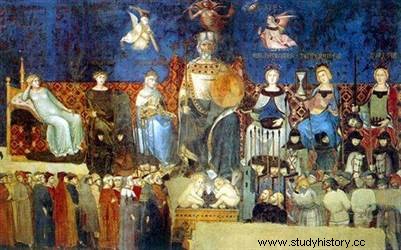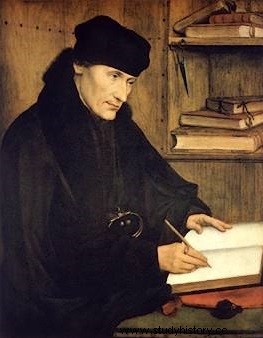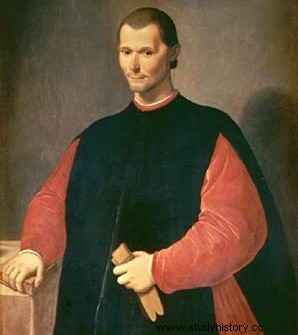 The "mirror to princes ”, if we stick to the definition proposed by the historian Einar Már Jónsson, is a literary genre, correlated to the political treatise, which appeared within the Carolingian world during the 9th century, and which emerged in the German historiography at the beginning of the 20th century, first with Albert Werminghoff, then with Ernst Booz. These works were intended for princes, as their name indicates. They consisted of collections presenting a sum of moral precepts to be followed by the sovereign with a view to the best possible religious government.
The "mirror to princes ”, if we stick to the definition proposed by the historian Einar Már Jónsson, is a literary genre, correlated to the political treatise, which appeared within the Carolingian world during the 9th century, and which emerged in the German historiography at the beginning of the 20th century, first with Albert Werminghoff, then with Ernst Booz. These works were intended for princes, as their name indicates. They consisted of collections presenting a sum of moral precepts to be followed by the sovereign with a view to the best possible religious government.
The medieval “mirror of princes”
In the Middle Ages, according to the "mirrors to princes only the will of God was to take precedence in government, in the exercise of sovereign power. The most striking work in this field was the Speculum regale , in other words the Royal Mirror , written in Norway and probably dating from 1260 , according to the historian Einar Már Jónsson, who identifies the existence of four kinds of “mirrors to princes ". The first type of work only enumerates the virtues with which the prince must be invested, as well as the vices which he must avoid at all costs. These are primarily moral considerations. The second uses examples of illustrious sovereigns, in order to define what is essentially an “ideal prince”, the perfect sovereign. The third relates to works that describe the virtues of the perfect sovereign, taking care to apply them to concrete and real situations. The moral is therefore no longer just made explicit, but it is explained to the reader.
In short, it is made intelligible. Finally, the fourth type of work is intended to be the representation of a more general reflection on the function of monarch and/or sovereign, extended to tangible and realistic cases. Jónsson has shown that these different types of works actually consist of a diachronic evolution, a progress, even a chronological precision of the genre. However, the "mirrors to princes » medieval texts for the most part contained only moral precepts and, for those who presented a reflection on the prince and his activity, the absence of an ideological sum was then striking. It was not until the 14th and 15th centuries that the genre was turned upside down, “revolutionized”.
The humanist “revolution” of gender
Humanists, whether from Italy or northern Europe, became, from the 15th century and during the 16th century, the privileged advisers of sovereigns. Nicolas Machiavelli and Leonardo Bruni were very characteristic examples of this phenomenon, they who vigorously served the interests of the Florentine Republic, by integrating the Chancellery, but also and above all by offering "advice" works intended to their rulers, to the "princeps .
 Renaissance ideas found unsuspected echoes until the 16th century, notably in the "well-known humanist belief established in the extreme solidity of the links between good education and good government “, according to the English historian Quentin Skinner, of the Cambridge school. The systematic production of pedagogical and political treatises was then, at this time, strongly encouraged, and we find revealing examples of this, whether in the work On Education by the Spaniard Juan Luis Vives, or in The Good Education of Boys by the Italian Iacopo Sadoleto. Other essential – and quite introductory – works followed, notably the illustrious Maître d’école by Roger Ascham, The Education of the Prince by Guillaume Budé and, above all, The Education of a Christian Prince of Erasmus. Consequently, we can find ourselves faced with a number of treatises, books of political advice which, according to Quentin Skinner, "are addressed not only to kings and princes, but also to courtiers, nobles , councilors and magistrates . »
Renaissance ideas found unsuspected echoes until the 16th century, notably in the "well-known humanist belief established in the extreme solidity of the links between good education and good government “, according to the English historian Quentin Skinner, of the Cambridge school. The systematic production of pedagogical and political treatises was then, at this time, strongly encouraged, and we find revealing examples of this, whether in the work On Education by the Spaniard Juan Luis Vives, or in The Good Education of Boys by the Italian Iacopo Sadoleto. Other essential – and quite introductory – works followed, notably the illustrious Maître d’école by Roger Ascham, The Education of the Prince by Guillaume Budé and, above all, The Education of a Christian Prince of Erasmus. Consequently, we can find ourselves faced with a number of treatises, books of political advice which, according to Quentin Skinner, "are addressed not only to kings and princes, but also to courtiers, nobles , councilors and magistrates . »
In this respect, the most famous example remains The Book of the Courtier by Baldassare Castiglione. The "mirror to princes is no longer content to simply present its reader with moral precepts. From now on, it is a question of proposing an education to follow, to which the sovereign must conform, in the perspective of good government, of "buon governo ". In any case, and therefore, it is the advent of Reason of State – as a literary genre – at the beginning of the 16th century, which changed the situation. A transition therefore seems to be taking place.
The role played by reason of state within the genre of the “mirror to princes”
From then on, religion was relegated to the background in the reflection on the exercise of power, in the government of the prince, and in his unwavering sovereignty. Also questions relating to reason of state , to conservation per fas et nefas of power by the princeps , are they characterized by a desire for political affirmation and emancipation, and not an intrinsic reflection on religious practice. This is more than a break with the medieval tradition of the “mirror to princes », to propose to the rulers precepts which are now purely political, and rid of any religious and/or moral dimension. We must also compare this shift from religion to politics with the advent of the modern state at the same time. Morality is then replaced by pragmatism.
 The Florentine Nicolas Machiavelli has, moreover, very well illustrated the phenomenon, in his major work The Prince . Certainly, the Machiavellian sovereign must be ontologically invested with moral virtues if he wants to carry out his government. Nevertheless, he must not hesitate to upset his ethics, if the sustainability and security of his State are in danger or undermined by various and varied causes. It is moreover for this precise reason that the pontifical power placed The Prince on the index in 1559 , year of the end of the Italian Wars and the signing of the Treaty of Cateau-Cambrésis . In short, nothing takes precedence more than reason of state for Machiavelli, who wanted to provoke reflection in his reader. Félix Gilbert, in a work dedicated to the Florentine and his compatriot and friend Guichardin, said of him that he:“Gave free rein to his penchant for paradoxes […] he wanted his writings to have a practical effect. His aim was to teach those in power what he had learned about the nature and workings of politics, and to urge them to act in accordance with his science . »
The Florentine Nicolas Machiavelli has, moreover, very well illustrated the phenomenon, in his major work The Prince . Certainly, the Machiavellian sovereign must be ontologically invested with moral virtues if he wants to carry out his government. Nevertheless, he must not hesitate to upset his ethics, if the sustainability and security of his State are in danger or undermined by various and varied causes. It is moreover for this precise reason that the pontifical power placed The Prince on the index in 1559 , year of the end of the Italian Wars and the signing of the Treaty of Cateau-Cambrésis . In short, nothing takes precedence more than reason of state for Machiavelli, who wanted to provoke reflection in his reader. Félix Gilbert, in a work dedicated to the Florentine and his compatriot and friend Guichardin, said of him that he:“Gave free rein to his penchant for paradoxes […] he wanted his writings to have a practical effect. His aim was to teach those in power what he had learned about the nature and workings of politics, and to urge them to act in accordance with his science . »
The purpose of this short article was to establish a general overview of the history of the literary genre of the "mirror to princes “, halfway between the Middle Ages and the beginning of the modern era. Over the centuries, as states are structured and consolidated, the concerns that are at the heart of issues relating to the exercise of power change and are transformed. We then pass, in the space of a few centuries, from a religious and moral authority, to the practice of an essentially political government. In this, humanism and the Renaissance cheerfully contributed to the phenomenon.
Bibliography
- JÓNSSON Einar Már, “Are “mirrors to princes” a literary genre? », in Medieval, 51 (2006), p. 153-166.
- GILBERT Félix, Machiavelli and Guichardin. Politics and history in Florence in the 16th century, Paris, Seuil, 1996.
- BORGNA Romain, FAGGION Lucien (dir.), The Prince by Fra Paolo. Political practices and forma mentis of the patriciate in Venice in the 17th century, Aix-en-Provence, University of Provence, 2011 [development on the genre of the “mirror to princes”, p. 115-118].
